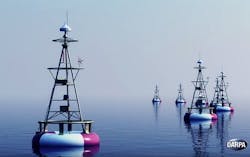Oceaneering eyes optical fiber-and-buoy emergency military communications backup
Officials of the Space and Naval Warfare Systems Center Pacific in San Diego announced a potential $19.3 million contract to Oceaneering on Monday to develop and demonstrate designs to restore connectivity for tactical data networks using small-diameter optical fiber and buoy relay nodes at sea.
This contract involves the second phase of the Tactical Undersea Network Architectures (TUNA) program of the U.S. Defense Advanced Research Projects Agency (DARPA) in Arlington, Va.
The DARPA TUNA program finished its initial phase late last year after developing concepts and technologies aimed at restoring connectivity for U.S. forces when traditional tactical networks are knocked offline or otherwise unavailable.
In this next phase Oceaneering experts will demonstrate a prototype of the system at sea. The project aims at using optical fiber to restore radio frequency (RF) tactical data networks temporarily in a contested environment via an undersea optical fiber backbone.
Related: DARPA to keep military communications open with floating optical fiber and networking buoys
The concept involves deploying RF network node buoys dropped from aircraft or ships that are connected via thin underwater fiber-optic cables. These very-small-diameter fiber-optic cables will be able to last 30 days in the rough ocean environment, which is long enough to provide essential connectivity until primary methods of communications are restored.
story continues below
The first phase of the program involved modeling, simulation, and at-sea tests of components for an undersea network, says John Kamp, program manager in DARPA’s Strategic Technology Office. “Teams were able to design strong, hair-thin, buoyant fiber-optic cables able to withstand the pressure, saltwater, and currents of the ocean, as well as develop novel power generation concepts,” Kamp says.
During the first phase of the program, the University of Washington’s Applied Physics Lab (APL) developed the Wave Energy Buoy that Self-deploys (WEBS), which generates electricity from wave movement. The WEBS system is designed to fit into a cylinder that could be deployed from a ship or aircraft.
The initial phase of the DARPA TUNA program had three primary thrusts: system designs; small undersea fiber optic cables; and buoy node systems.
System designs involved studies for system architectures that integrate a military tactical data network with a rapidly deployable temporary undersea network.
Small fiber optic cable systems involved lightweight, buoyant unpowered optical fiber technologies that can survive deployment and operation in the ocean for at least 30 days.
Buoy nodes involved rapidly deployable communications buoy designs to interconnect the tactical data network and the undersea fiber optic network. Buoys should function as relays and energy sources, and should be rapidly deployable from Navy ships, submarines, and aircraft, and work with tactical data and undersea fiber optic networks.
Now Oceaneering moves forward to the second phase with the design and implement an integrated end-to-end system, and to test and evaluate this system in laboratory and at-sea demonstrations using the Link 16 tactical data network used by U.S. and allied forces’ aircraft, ships, and ground vehicles.
On this contract Oceaneering will do the work at the company's facilities in Maryland, as well as at government test facilities in Southern California, and should be finished by September 2018.
For more information contact Oceaneering International online at www.oceaneering.com/naval-marine-services/otech.
Learn more: search the Aerospace & Defense Buyer's Guide for companies, new products, press releases, and videos
